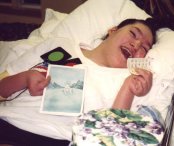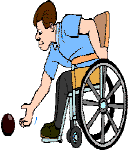The Cerebral Palsy Network
- Spasticity Chart
- Team Approach
- Oral Medications
- ITB
- Rhizotomy
- Orthopedic Surgery
- Brain Injuries
- Casts & Braces
- Physical Therapy
- Glossary Terms
- Credits
- Botox
Around CPN
Resource
Center
ORAL AND INTRAMUSCULAR
Medications
by Deborah Gaebler-Spira, M.D.
Oral and injected medications are now more effective and predictable in treating spasticity. They can be selected and dose-adjusted to target specific rehabilitation goals, such as improving functional goals such as improving functional limitations. These medications may enhance an individual's ability to sit, stand, or walk, as well as maintain appropriate postures (positioning). In turn, such enhanced capabilities may improve communication skills, directly by decreasing spasticity of throat and tongue muscles, or indirectly by enabling comfortable sitting and standing, thus making it easier to pay attention.
Oral medications
Oral medications can produce partial, short-term improvement for children ( as young as two years) and young adults with spasticity. While injectable medications only affect specific muscles, oral medications act throughout the body. The most commonly prescribed medications taken by mouth are baclofen (Lioresal®);diazepam (Valium®); and dantrolene (Dantruim®). All are mildly effective; however no oral medication can entirely eliminate symptoms of moderate to severe spasticity. Doses are started as low levels for each drug and then are increased gradually until spasticity improves or unacceptable side effects ( such as drowsiness or unsteadiness) occur.
Baclofen, the most often prescribed oral medication, resembles the chemical structure of GABA, the body's natural biochemical that acts to prevent spasticity. For effectiveness as a muscle relaxant, baclofen must reach the spinal cord. Baclofen's impact may take an hour or more to become apparent; its effective period lasts about eight hours. Therefore a three or four times daily dose is common.
Diazepam is the second most popular oral medication. Although it is absorbed and takes effect rapidly, diazepam stays in the body much longer than baclofen.
Doses are given two to three times a day, for a maximum total of 20 mg. (tablets or liquid). Dosage might be increased after a few months if tolerance develops.
Although both baclofen and diazepam act on the central nervous system (CNS), diazepam is more likely to produce drowsiness, unsteadiness or short-term memory deficit. In addition, some individuals become physiologically dependant on diazempam. Dosages must be tapered off slowly.
Dantrolene acts on the muscles themselves rather than on the CNS. It slightly decreases muscle tone so that spastic muscles are incapable of extreme tightening. Given in two to four doses daily, dantrolene is increased every few days to a total maximum daily dose of 12 mg. It is less likely to cause drowsiness, confusion or other CNS side effects. A serious side effect can be liver damage in about one percent of those individuals taking dantrolene, especially adolescents and young adults. Blood tests to monitor liver enzyme levels are recommended two to four times annually.
Tizamidine hydrochloride (Zanaflex®) was approved by the FDA in December 1998 for treatment of adults with spasticity due to spinal cord injuries or multiple sclerosis(MS). Physicians who have used tizanidine for treatment have found it a useful therapeutic alternative for patients with spasticity associated with MS or spinal cord damage, because muscle weakness appears to be less of a resulting problem than with other medications used to treat spasticity. Some physicians have also found the drug useful for muscle spasms that last for hours. The safety and effectiveness of the drug for children and adolescents with spastic cerebral palsy has not been sufficiently tested.
Liver enzyme levels should be monitored to guard against the risk of liver damage in all people taken tizanidine hydrochloride. Other side effects include dry mouth, drowsiness and low blood pressure.
Some physicians have found off-label use (use of a drug in treatment of a condition for which it has not been approved, but for which informed consent has been given) of the anticonvulsant vigabatrin (Sabril®)- available in Canada and the UK, but not the US- effective in helping some adults with spasticity due to spinal cord injuries or MS. As with tizanidine, adolescents with spastic cerebral palsy has not been sufficiently tested.
Intramuscular injections
Injecting medications directly into spastic muscles may reduce their spasticity. These medications affect only those injected muscles and very rarely cause CNS side effects.
- Alcohol and pheno intramuscular injections (called motor point blocks) are used, although they may cause muscle tenderness for a few days.
- Botulinum toxin (Botox®) is now used frequently. A purified derivative of the toxin that causes botulism ( a type of food poisoning), Botox is safe when injected directly into spastic muscles in appropriately small doses, although it can defuse into adjacent muscles. Dosages, the number of injections and their exact location vary according to the size of the muscles being injected and the severity of the spasticity. Although Botox is not yet specifically approved by the FDA for children with cerebral palsy, approval has been requested and Botox has been injected into hundreds of children with success. (Physicians can get informed contend from adults or from parents on a child's behalf to try a medication for a specific purpose before it is officially approved for that purpose.) When the goal is to reduce spasticity in only one or a few muscles, injected medications are desirable because of the length of relief to provide and their low side effect profile. Muscle spasticity is usually reduced significantly within two or three days following the injections, and relief may last four to six months. During that time, physical therapists may do serial casting and therapy to increase range of motion.
credit for this article goes to Deborah Gaebler-Spira, M.D. and Exceptional Parent Magazine.
This site designed & maintained by Mystic Dawn Web Creations. The Cerebral Palsy Network©1997/2003. All graphics are the exclusive property of CPN, unless otherwise indicated. Contact CPN at Cerebral Palsy Network for further information.
Last updated

Amanda the reason CPN was
started
CPN
Reunion 2003

CP
Research
What's happening Today with
Cerebral Palsy

Special
Olympics
What's happening with
Special Olympics in 2003

CP
& Education
What's happening with
Special Need and Education in 2003